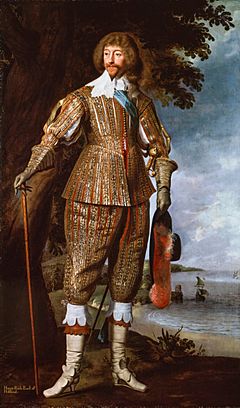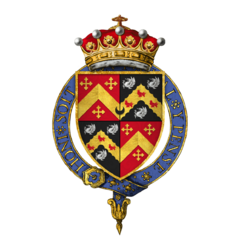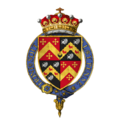Henry Rich, 1st Earl of Holland facts for kids
Quick facts for kids
The Earl of Holland
|
|
|---|---|
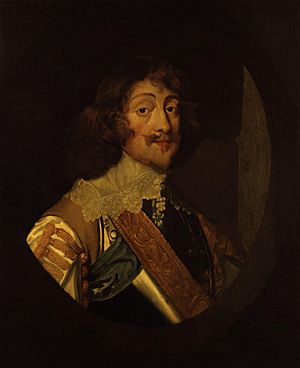
Henry Rich, 1st Earl of Holland by Anthony van Dyck, circa 1640
|
|
| Chancellor of the University of Cambridge | |
| In office 1628–1649 |
|
| Governor of Windsor Castle and Landguard Fort | |
| In office 1628–1648 |
|
| Lord Lieutenant of Berkshire & Middlesex | |
| In office 1628–1643 |
|
| Groom of the Stool | |
| In office 1636–1643 |
|
| Privy Council of England | |
| In office 1624–1642 |
|
| Member of Parliament for Leicester |
|
| In office April 1614 – June 1614 |
|
| Personal details | |
| Born | 15 August 1590 (baptised) London |
| Died | 9 March 1649 (aged 58) New Palace Yard, Westminster |
| Resting place | St Mary Abbots |
| Nationality | English |
| Spouse | Isabel (1612 – until his death) |
| Children | Frances (1617–1672); Robert (1619–1675); Henry (1620–1669); Isabella (1623–1670); Susannah (1628–1649); Diana (d. 1659); Charles (d. 1645); Cope (1635–1676); Mary (1636–1666) |
| Parents | Robert Rich, 1st Earl of Warwick Penelope Devereux |
| Residence | Holland House |
| Alma mater | Emmanuel College, Cambridge |
| Occupation | Soldier and courtier |
| Military service | |
| Rank | General |
| Battles/wars | War of the Jülich Succession Siege of Jülich (1610); Eighty Years War Anglo-French War (1627–1629) Siege of Saint-Martin-de-Ré; Wars of the Three Kingdoms First Battle of Newbury; Battle of St Neots (1648) |
Henry Rich, 1st Earl of Holland (born 15 August 1590, died 9 March 1649) was an English courtier and politician. He was captured while fighting for the Royalists during the Second English Civil War. Later, he died after a trial by Parliament.
Henry was the younger brother of Robert Rich, 2nd Earl of Warwick. His brother was a Puritan and led the Parliamentarian navy. Henry, however, was known as a very stylish and successful courtier.
He was a close friend of King Charles I and his favorite, the Duke of Buckingham. Henry helped with important tasks, like arranging King Charles' marriage in 1625. He also took part in a difficult attack in 1627. During the 1630s, he held many important jobs at court.
When the First English Civil War began in 1642, Henry stayed in London. He did not join the Royalists right away. Like many others, he became tired of the war. In 1643, he tried to get his cousin, a Parliamentarian general, to make peace. When this failed, Henry joined the Royalists.
After King Charles made a truce in 1643, Henry returned to London. He almost faced serious charges for going against Parliament. When peace talks failed in 1647, he fought for the Royalists again in the Second English Civil War. He was captured in 1648. Henry was tried and died in March 1649. He always claimed he was loyal to Parliament's original ideas. Many moderate Parliamentarians agreed with him, especially after King Charles I's own life ended in January 1649.
Contents
Henry Rich's Early Life and Family
Henry Rich was the second son of Robert Rich, 1st Earl of Warwick (1559–1619). His mother was Penelope (1563–1607). He was one of four children.
Henry's parents separated shortly after he was born. They officially divorced in 1605. His mother then married Charles Blount, 8th Baron Mountjoy. Henry's mother was the sister of the Earl of Essex. This made Henry a cousin to Robert Devereux, 3rd Earl of Essex, who later became a Parliamentarian general.
Henry had two sisters, Essex and Lettice. His brother was Robert Rich, 2nd Earl of Warwick. He also had several half-brothers and sisters. These children were raised within the Rich family.
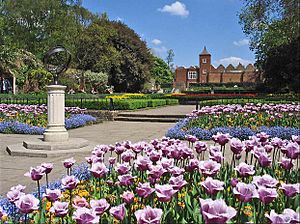
His father, Robert, was a very wealthy landowner in Essex. He became the Earl of Warwick in 1618. The family supported changes within the Church of England. While his older brother was a strict Puritan, Henry was known for being stylish and successful at court.
In 1612, Henry married Isabel Cope. Her family gave her a large sum of money and a house in Kensington. Henry greatly expanded this house between 1624 and 1625. He renamed it Holland House. Much of the house was destroyed in 1940, but parts still remain today.
Henry and Isabel had many children. These included Frances, Robert, Henry, Isabella, Susannah, Diana, Charles, Cope, and Mary. Many family members are buried at St Mary Abbots Church, Kensington.
Henry Rich's Career Before 1639
Henry Rich went to Eton and then to Emmanuel College, Cambridge in 1603. It is said that Henry IV of France was his godfather. He traveled to Paris in 1607 and returned to England in 1610.
He was elected as a MP for Leicester. In June, he was made a Knight of the Garter. This happened when King James I's son, Henry, became Prince of Wales. Soon after, Henry volunteered in a military campaign in 1610. This was part of a larger conflict before the Thirty Years War.
Henry also studied law in 1611. He was re-elected for Leicester in 1614. People at the time described him as very handsome and charming. However, he also needed wealth to advance. His father-in-law died with many debts, which affected Henry's finances.
Henry became close to Prince Charles and his favorite, the Duke of Buckingham. He went on several diplomatic trips. He also served briefly in the Eighty Years War. In 1623, he was given the title Baron Kensington. The next year, he joined the Privy Council of England. This was a group of advisors to the king.
Henry was sent to Paris to help arrange the marriage between Charles and Henrietta Maria of France. When Charles became king in 1625, Henry was made Earl of Holland. His title came from an area in Lincolnshire.
In 1627, Henry was part of a difficult military attack called the Siege of Saint-Martin-de-Ré. This event led to the Duke of Buckingham being accused by Parliament. After Buckingham's death in 1628, Henry wrote to King Charles. He asked to be made Governor of Windsor Castle. He received this job, along with being Governor of Landguard Fort.
Henry also benefited from his friendship with Queen Henrietta Maria. She became King Charles's closest advisor. Over the next few months, Henry received many other important jobs. These included Lord Lieutenant of Berkshire and Middlesex, and Chancellor of the University of Cambridge.
The 1630s were the best years of his career at court. As a Privy Councillor, he often advised on foreign affairs. In 1636, he became Groom of the Stool. This important role showed his close relationship with the king.
Henry Rich and the English Civil War
Despite his close ties to the king's court, Henry Rich and his brother Warwick were seen as leaders among the Puritans. This shows that being a "Puritan" could mean having certain political views, not just religious ones. Many people who supported Parliament during the Civil War were Puritans.
Henry used his influence to appoint religious leaders who shared his views. He was against certain religious practices that were becoming popular. This caused problems with Queen Henrietta Maria, who was a Catholic. Henry also supported two main causes for the Puritan movement. One was helping King Charles's Protestant nephew regain his lands in Germany.
The second cause was supporting English colonies in the West Indies and North America. These areas were mostly controlled by Spain. Henry supported colonies in Virginia and Bermuda. From 1630 to 1642, he was governor of the Providence Island Company. He helped get money and support for these activities. Many of his colleagues in this company later became leaders of the Parliamentarian side in 1641.
The Wars of the Three Kingdoms started in 1639. Henry served as a general in a war against the Scots. This campaign ended without much fighting. A second defeat in 1640 forced King Charles to call Parliament. This Parliament accused important royal advisors. Henry had long opposed one of them and gave evidence against him.
Although King Charles made him commander of the local army in Northern England, Henry sided with Parliament. This was at the start of the First English Civil War in August 1642. Many people thought the war would be short. They were shocked by the many deaths at Edgehill in October 1642.
In early 1643, Henry tried to convince his cousin, a Parliamentarian general, to make peace. When this failed, Henry joined the Royalists in Oxford. He was present at a battle in September. However, King Charles did not treat him well. Henry returned to London in November. He reportedly disagreed with a truce the Royalists made in Ireland.
He took his seat again in the House of Lords. An attempt to accuse him of going against Parliament was blocked. Henry was one of ten lords chosen for the Westminster Assembly. This group worked with Scottish representatives to change the Church of England.
By the time King Charles surrendered in 1646, his opponents were divided. There were moderates in Parliament and more radical groups in the army. Peace talks between the king and Parliament failed in late 1647. The Scots, English moderates, and Royalists formed an alliance. They wanted to restore King Charles to the throne. The Second English Civil War began in April 1648.
On July 4, 1648, a request was made to Parliament to restart talks with King Charles. On the same day, Henry Rich and another nobleman gathered 400 cavalry. They tried to take control of London. This force was too small. The Royalists retreated and were stopped outside Surbiton.
Henry and 200 men reached St Neots on July 9. They were joined by an experienced German soldier. The next day, they were attacked by a Parliamentarian group. The German soldier was killed. Henry was captured and taken to Windsor Castle.
The war ended with a Parliamentarian victory in August. King Charles I's life ended on January 30, 1649. On February 27, Henry was taken to London for trial. Many felt he should have been punished earlier. Despite pleas from his brother, Henry died on March 9, 1649. Two other noblemen also died with him.
Before his death, Henry wrote a statement. He claimed he had always been loyal to Parliament. This was a surprising claim since he had changed sides twice. However, he also suggested he never changed his core beliefs. Many moderate Parliamentarians agreed with this view.
Images for kids


